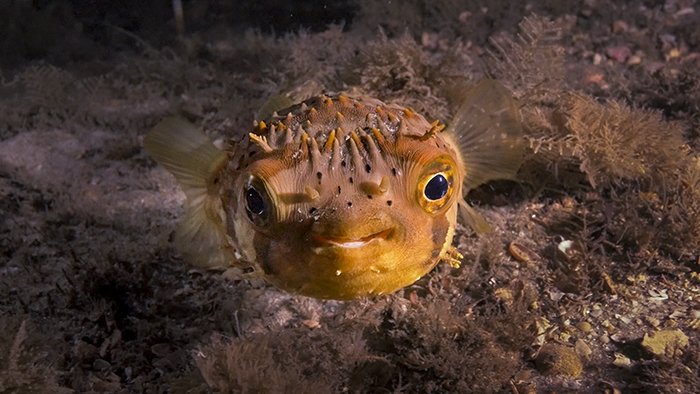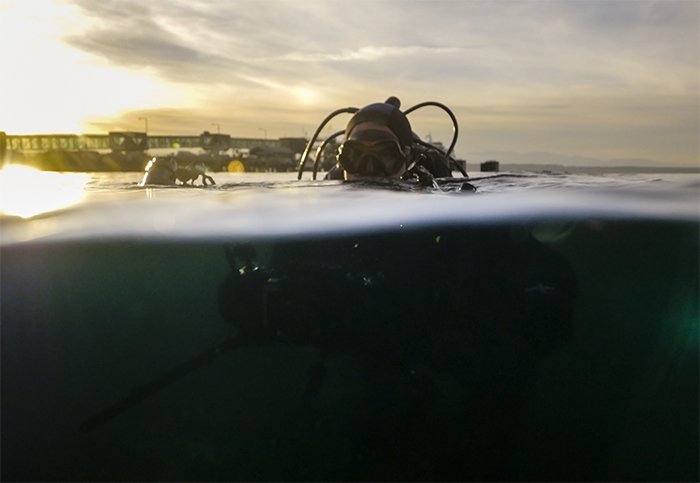Recognizing the Riot, Delighting in the Dance
The Riot and the Dance: Water
The Riot and the Dance films are reclaiming the nature documentary genre for the Creator’s glory. And Gordon Wilson is having the adventure of a lifetime.
Many Christians, like me, love nature and crave seeing creatures that display the Creator’s intelligence, wisdom, and majesty. We explore the natural world when we get the chance. When we can’t, we watch nature shows.
For decades, secular filmmakers, such as the BBC and National Geographic, have scratched that itch for us. They bring the breathtaking glory of creation to laypeople who would normally never see it. As pioneers in the industry, they have honed their craft well—so well, in fact, their work still makes my jaw drop.
Tragically these same filmmakers are Darwinists to the core. Their cinematography is astounding, their narration engaging. Yet because of their evolutionary worldview, their productions are intelligently designed to deny that nature was intelligently designed. Secular evolutionists are ideologically bound to give all glory and gratitude to mindless, purposeless evolutionary processes. But to say that nature is the result of blind Darwinian processes rather than the product of an omnipotent Creator is about as blasphemous as you can get.
In the spring of 2015, my nephew N. D. (Nate) Wilson, a zealous Christian and young-earth creationist, asked me to narrate a nature documentary. This was shortly after Andrew Crapuchettes, a local Christian entrepreneur, asked Nate to direct a Christian nature documentary. Crapuchettes’ family enjoyed watching nature shows, but he was tired of the “Darwin detox” necessary during and after watching. He wanted to invest a generous sum in a production that glorified God by showcasing creation with the cinematic excellence of mainstream documentaries.
As Nate’s uncle, friend, and next-door neighbor, as well as a fire-breathing creationist, I was an obvious fit for the narrator role. I was also an outdoorsy, nature-loving biology professor. What else did he need?
The Riot and the Dance films that resulted have a tiny fraction of BBC-level resources, such as budget, cameramen, time—you name it. From a worldly perspective, we are at an obvious disadvantage. Then again so were Gideon, Asa, Hezekiah, and many others throughout Scripture. But when you have the truth and when you put your trust in the Lord and seek him, you will “lack no good thing” (Psalm 34:10).
The first film, The Riot and the Dance: Earth, debuted in 2018. Our second film, The Riot and the Dance: Water, releases this spring—and we plan to make more in the future. With the vastness of God’s creation, we will never run out of material.
Choreography of Nature
Since the first Riot and the Dance film focused on land animals, we wanted part two to feature aquatic animals. But whether on land or in the sea, we knew that we would encounter creatures groaning due to the curse (Romans 8:22). Anytime you showcase animal life, you realize that much in nature is riot—anatomy, physiology, and behavior that explicitly proclaim the fall.
We unapologetically address this issue of natural evil. But at the same time, we didn’t want the film to be morbid or depressing. Much more than riot, the natural world features plenty of dance, echoing the perfect pre-fall creation. Choreographed behaviors, such as courtship and mutualism (reliance on one another), are a dance enhanced by the astounding beauty, diversity, and complexity of aquatic creatures.

This long-spine porcupine fish, off the coast of Florida, seemed unperturbed by the film crew’s presence.
Seeing the Fall and Longing for Redemption
Secular nature documentaries capitalize on the complex biological weaponry used in this conflict because they know, as creationists do, that it’s magnificent. Of course, they wrongly assume it’s produced by evolutionary processes over eons of time. It’s just the way things are, they say—a dog-eat-dog world. No need to bemoan it.
Creationists, on the other hand, acknowledge the Creator’s handiwork while understanding that death is an enemy to be destroyed. So how could God, who is holy and good, create natural evil?
The answer is simple: “The wages of sin is death” (Romans 6:23). God is not only good, he is also just. After Adam’s sin, the Creator crafted those sophisticated death-dealing attributes of predators and parasites. But the goodness of God and his divinely designed deadly weapon systems do not contradict one another. When God designed creatures capable of killing us and other animals, he manifested his righteous and holy justice—a global punishment for our sin.
But the fall highlights the good news of the gospel. To free us from this curse of death, the Son of God was crucified. The wrath of God was poured out on Jesus. Not only are we redeemed spiritually, but we, along with the entire creation, will one day be liberated from our bondage to decay and death.
The Adventure Begins
My nephew Nate is a good man but not a tame one. So when I agreed to narrate The Riot and the Dance series, I knew what I was getting into precisely because I knew I couldn’t know what I was getting into. I was in for a wild time, with more riot than dance. Indeed, brushing shoulders—and fins—with some of God’s most fascinating creatures has been the adventure of a lifetime.
Filming has taken us to the dry zone, rainforests, cloud forests, and coasts of Sri Lanka; the mountains of Idaho; the coasts of Oregon and California; Yellowstone National Park; and the Sonoran Desert in North America—and that was just part one of the series. For The Riot and the Dance: Water, we descended into the depths to encounter a broad array of creatures in freshwater and marine ecosystems, such as tropical coral reefs in Hawaii, the cold waters of Hood Canal in Washington State, tropical and temperate open oceans, the Monterey Bay kelp forests in California, freshwater springs of Florida, the everglades, and the salmon runs up the Pacific Northwest rivers.

Film director James Engerbretson uses a Red Epic camera to shoot footage of a river in Washington State’s Olympic Peninsula.
Getting Chummy with Sharks
We started shooting the second film well before we finished filming the first. In August of 2016, Oahu, Hawaii, was our first trip exclusively for filming The Riot and the Dance: Water.
We planned to get the film team certified in scuba diving in two days and film as much as possible in four days. Our main objectives were to film coral reef creatures off Oahu’s southern shore and sharks off the northern shore. With no time to lose, we even filmed while training.
I normally don’t experience motion sickness, so I figure I must have caught some intestinal virus in Hawaii. I felt fine on the boat, but when I was diving, the ocean swell got to me. “Tossing my cookies” on the reefs of Waikiki was no big deal, but it was a different story when we were being circled by 20–30 sandbar and Galapagos sharks. One day, feeling an intense wave of nausea, I hurriedly swam toward the boat ladder, planning to get on deck, rush to the other side of the boat, and hurl. I didn’t make it.
At the top of the ladder, I chummed the water where the sharks and cameramen were swimming. The smaller fish eagerly greeted this bonanza of food I had so generously provided. As they started darting for the free meal, the sharks got more excited. My dismayed diving companions, whose cameras documented this chain reaction, wondered for a moment at the source of all this fish food. Eventually, they put two and two together and knew it was time to leave the water until things settled down.
To Catch a Prey

The moray eel might not be the first creature you look for in an aquarium. But after the fall, the Creator equipped eels with remarkable hunting abilities that warrant a second look.
As ambush predators, morays hide in coral reefs, waiting for a tasty creature to wander by and then—bam!—they strike. Morays use a second set of jaws (called pharyngeal jaws) set way back in their throat. When the normal jaws have a hold of the prey, muscles pull these jack-in-the-box jaws (armed with backward-pointing teeth) forward to chomp the part of the prey that’s deep in the mouth. Then other muscles haul these jaws back, and the moray swallows its prey. With this kind of double jeopardy, prey don’t stand a chance.
Armed with these unique features, moray eels don’t avoid bigger snacks like octopuses. During an attack, to avoid the grip of the octopus’ arms, some morays tie themselves in knots.
Sometimes these eels choose to hunt the easy way—by joining with others. Morays often let other fish attack first and then feast on any leftovers.
Striking Cinematic Gold
In November of 2017, my son Dane (one of the two cameramen) and I went to Monterey Bay in California. Our first night there, we took a cold-water dive to explore the kelp forest. The next day we dove near sea lions basking on the pier of the Monterey Coast Guard station. They joined us in the water and swirled around us, a living tornado of curious sea creatures.
That afternoon our captain took us out farther from shore to film humpback whales still lingering in the bay before heading for warmer southern waters. We filmed quite a bit of surfacing, blowing, fluking, and pec-fin slapping. But as the day wore on, the whale activity intensified.
We were cruising with a few male humpbacks, just hoping for the ultimate experience in whale watching—a whale breaching out of the water. With anticipation, Dane was filming in super slow motion using our Red Epic (the Cadillac of Hollywood cameras) when a humpback breached not far off our port side. We hollered, we whooped, we laughed. “Did you get it, Dane?” I asked.
“Yeah, baby!” he blurted.
We knew we’d struck cinematic gold.

Washington State’s Puget Sound provided many fantastic filming opportunities for cinematographer Dane Wilson.
Herman the Sturgeon
In addition to marine life, we also wanted plenty of freshwater creatures in the film—the bigger the better. With this in mind, we traveled to the Bonneville Dam on the mighty Columbia River. There we met a famous Oregon citizen—an 11-foot, 82-year-old white sturgeon named Herman and several of his sturgeon buddies. As you might expect of an octogenarian fish, Herman has a colorful personal story. You can hear a bit of what Herman has been through when you watch The Riot and the Dance: Water.
It was wonderful to dive in Herman’s beautifully landscaped pond with these long-lived giants gliding by inches from my face mask. Sturgeon move between estuaries and large rivers (where they spawn) in their youth, feeding on a variety of invertebrates but switching to a mostly fish menu as they get bigger. While foraging for food, they cruise near the bottom, using their sensory catfish-like whiskers, called barbels, to help detect prey in their dark, murky habitat. The barbels around their mouth along with two rows of bony plates down their back make sturgeon look like a cross between a catfish and a dinosaur—just another example of God’s awe-inspiring creativity.

In his 82 years, Herman the sturgeon has lived an exciting life—for a fish.
Moment with a Manatee
For a change in ecosystems, we headed to the freshwater springs of the Crystal and Homosassa rivers in Florida to film some other gentle giants—manatees. The difference couldn’t have been starker between the sharks in Hawaii and the manatees. The creatures wildly differed in their anatomy, physiology, speed, diet, and life cycle. But even greater was the difference in my emotions toward them—serenity with the manatees and intensity with the sharks. Both wonderful experiences were a reminder of the diversity in God’s creation.
After one particularly long snorkeling session with the manatees, I was chilled to the bone and had just gotten comfortable with a cup of hot chocolate in the boat’s heated cabin when Dane hollered for me to come back outside. He was at least 30 yards away, and I couldn’t make out why he was so excited. But even if he had just discovered a chest of gold doubloons, I wasn’t about to go back in the cold water.
What I couldn’t see was a friendly female manatee hugging Dane with great affection. But his footage of the amusing encounter made it in the film for me—and you—to enjoy.
Better Than Glasses

When humans have poor vision, the eye doctor prescribes contacts or glasses—problem solved. But a manatee can’t go to the eye doctor. Though its daytime eyesight isn’t the greatest, a manatee manages. At nighttime, if it had only its eyes to sense its surroundings, it would blunder its way along.
Thankfully, our lavish Creator bestowed upon them the perfect solution to nocturnal navigation—whiskers called vibrissae. A manatee has about 2,000 vibrissae on its face and about 3,000 smaller ones on its body. They help the manatee sense its surroundings, especially if the water is dark or murky.
In a recent study, researchers discovered that these body whiskers help the manatee detect water currents and underwater vibrations. They also allow the manatee to sense when other animals are in the area and navigate its watery habitat. While fish have a similar capability, the manatee is the only mammal we are aware of whose body vibrissae are completely devoted to sensing their environment.
It’s been a grand adventure to showcase the Creator’s handiwork while seeking to redeem the nature documentary genre for his glory.
Watching for the Riot and the Dance
It’s been a grand adventure to showcase the Creator’s handiwork while seeking to redeem the nature documentary genre for his glory. Lord willing, we will keep filming so that you can experience more of it along with us.
I hope you can experience a showing of The Riot and the Dance: Water when it comes out this spring. But don’t stop there. Experience the creation’s riot and dance for yourself. You don’t need to dive with manatees or encounter a humpback whale breaching beside your boat to enjoy nature. God’s glorious creatures are right outside your door. Walk in a nearby woodland, explore a stream or marsh, or inspect a weedy vacant lot. A curious mind and a sharp eye can make even your backyard a wilderness and the most mundane critter a wonder as you marvel at God’s masterpieces.
Related Downloads
A Different Shade of Green (Excerpt)
PDF DownloadAnswers Magazine
March–April 2020
The Riot and the Dance films are reclaiming the nature documentary genre for the Creator’s glory.
Browse Issue SubscribeRecommended Resources

Answers in Genesis is an apologetics ministry, dedicated to helping Christians defend their faith and proclaim the good news of Jesus Christ.
- Customer Service 800.778.3390
- © 2024 Answers in Genesis





